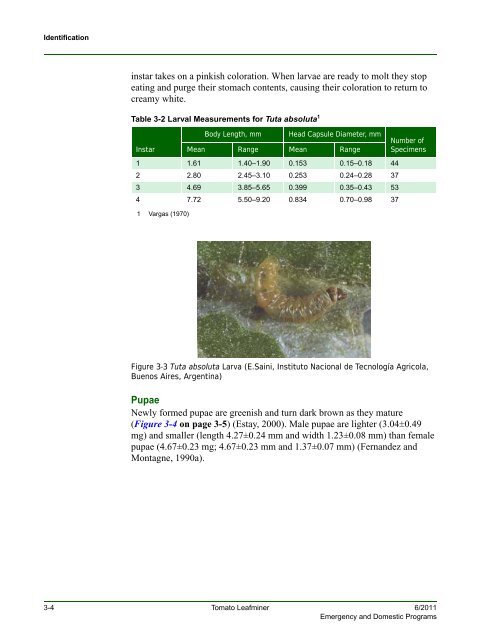1 - Phytosanitary Resources
1 - Phytosanitary Resources
1 - Phytosanitary Resources
You also want an ePaper? Increase the reach of your titles
YUMPU automatically turns print PDFs into web optimized ePapers that Google loves.
Identification<br />
instar takes on a pinkish coloration. When larvae are ready to molt they stop<br />
eating and purge their stomach contents, causing their coloration to return to<br />
creamy white.<br />
Table 3-2 Larval Measurements for Tuta absoluta 1<br />
Instar<br />
1 Vargas (1970)<br />
Body Length, mm Head Capsule Diameter, mm<br />
Number of<br />
Mean Range Mean Range Specimens<br />
1 1.61 1.40–1.90 0.153 0.15–0.18 44<br />
2 2.80 2.45–3.10 0.253 0.24–0.28 37<br />
3 4.69 3.85–5.65 0.399 0.35–0.43 53<br />
4 7.72 5.50–9.20 0.834 0.70–0.98 37<br />
Figure 3-3 Tuta absoluta Larva (E.Saini, Instituto Nacional de Tecnología Agricola,<br />
Buenos Aires, Argentina)<br />
Pupae<br />
Newly formed pupae are greenish and turn dark brown as they mature<br />
(Figure 3-4 on page 3-5) (Estay, 2000). Male pupae are lighter (3.04±0.49<br />
mg) and smaller (length 4.27±0.24 mm and width 1.23±0.08 mm) than female<br />
pupae (4.67±0.23 mg; 4.67±0.23 mm and 1.37±0.07 mm) (Fernandez and<br />
Montagne, 1990a).<br />
3-4 Tomato Leafminer 6/2011<br />
Emergency and Domestic Programs













